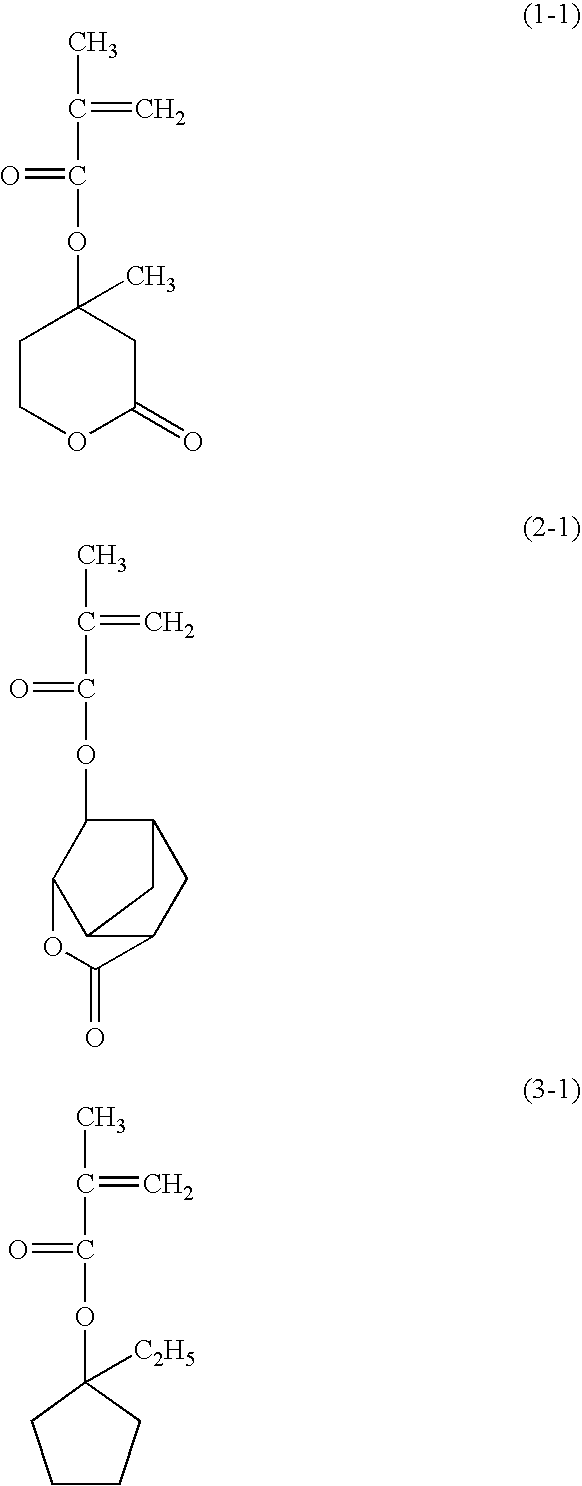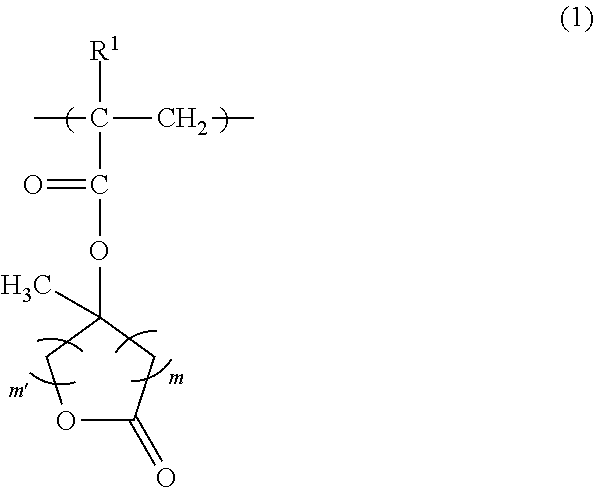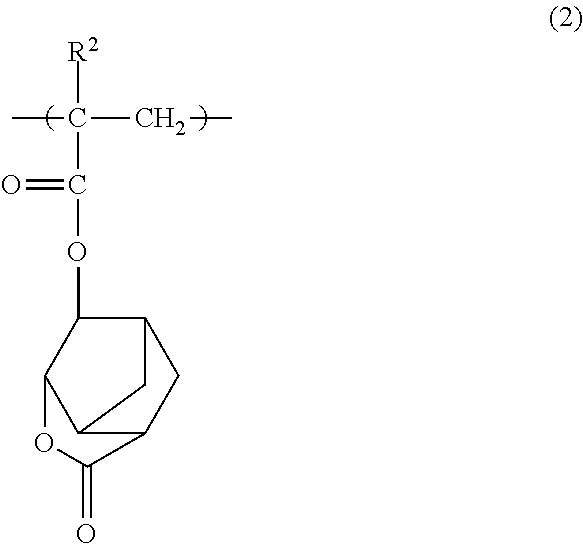Lactone copolymer and radiation-sensitive resin composition
a radiation-sensitive resin and copolymer technology, applied in the direction of photosensitive materials, instruments, photomechanical equipment, etc., can solve the problems of complex relation between chemical structure and characteristics of resin components, difficult to anticipate properties as resists, and extremely difficult to develop resists that can meet the required performance. , the effect of minimal line width change and high radiation resistan
- Summary
- Abstract
- Description
- Claims
- Application Information
AI Technical Summary
Benefits of technology
Problems solved by technology
Method used
Image
Examples
synthesis example 1
[0154]A monomer solution was prepared by dissolving 9.84 g (20 mol %) of a compound shown by the following formula (1-1) (hereinafter “compound (1-1)”), 22.06 g (40 mol %) of a compound shown by the following formula (2-1) (hereinafter “compound (2-1)”), and 18.10 g (40 mol %) of a compound shown by the following formula (3-1) (hereinafter “compound (3-1)”) in 100 g of 2-butanone, and further adding 2.86 g of dimethyl 2,2′-azobis(2-methylpropionate).
[0155]The monomer solution was added dropwise to 50 g of 2-butanone at 80° C. over 3 hours in a nitrogen atmosphere. After the addition, the reaction mixture was polymerized with stirring for 3 hours. After the polymerization, the reaction solution was cooled to room temperature and poured into 1,000 g of i-propanol. White precipitate produced was collected by filtration. The white powder obtained by filtration was washed with 200 g of i-propanol twice in a form of slurry, collected by filtration, and dried at 60° C. for 15 hours to obta...
synthesis example 2
[0158]A monomer solution was prepared by dissolving 4.96 g (10 mol %) of compound (1-1), 22.24 g (40 mol %) of compound (2-1), and 22.80 g (50 mol %) of compound (3-1) in 100 g of 2-butanone, and further adding 2.88 g of dimethyl 2,2′-azobis(2-methylpropionate).
[0159]The monomer solution was added dropwise to 50 g of 2-butanone at 80° C. over 3 hours in a nitrogen atmosphere. After the addition, the reaction mixture was polymerized with stirring for 3 hours. After the polymerization, the reaction solution was cooled to room temperature and poured into 1,000 g of methanol. White precipitate produced was collected by filtration. The white powder obtained by filtration was washed with 200 g of methanol twice in a form of slurry, collected by filtration, and dried at 60° C. for 15 hours to obtain 35 g of a white powder of copolymer [I] (yield: 70 wt %).
[0160]The resulting copolymer [I] was a copolymer with an Mw of 7,800 and the mol ratio of the recurring units derived from the compound...
synthesis example 3
[0161]A monomer solution was prepared by dissolving 4.86 g (10 mol %) of compound (1-1), 27.26 g (50 mol %) of compound (2-1), and 17.88 g (40 mol %) of compound (3-1) in 100 g of 2-butanone, and further adding 2.88 g of dimethyl 2,2′-azobis(2-methylpropionate).
[0162]The monomer solution was added dropwise to 50 g of 2-butanone at 80° C. over 3 hours in a nitrogen atmosphere. After the addition, the reaction mixture was polymerized with stirring for 3 hours. After the polymerization, the reaction solution was cooled to room temperature and poured into 1,000 g of methanol. White precipitate produced was collected by filtration. The white powder obtained by filtration was washed with 200 g of methanol twice in a form of slurry, collected by filtration, and dried at 60° C. for 15 hours to obtain 38 g of a white powder of copolymer [I] (yield: 76 wt %).
[0163]The resulting copolymer [I] was a copolymer with an Mw of 7,600 and the mol ratio of the recurring units derived from the compound...
PUM
| Property | Measurement | Unit |
|---|---|---|
| width | aaaaa | aaaaa |
| width | aaaaa | aaaaa |
| width | aaaaa | aaaaa |
Abstract
Description
Claims
Application Information
 Login to View More
Login to View More - R&D Engineer
- R&D Manager
- IP Professional
- Industry Leading Data Capabilities
- Powerful AI technology
- Patent DNA Extraction
Browse by: Latest US Patents, China's latest patents, Technical Efficacy Thesaurus, Application Domain, Technology Topic, Popular Technical Reports.
© 2024 PatSnap. All rights reserved.Legal|Privacy policy|Modern Slavery Act Transparency Statement|Sitemap|About US| Contact US: help@patsnap.com










